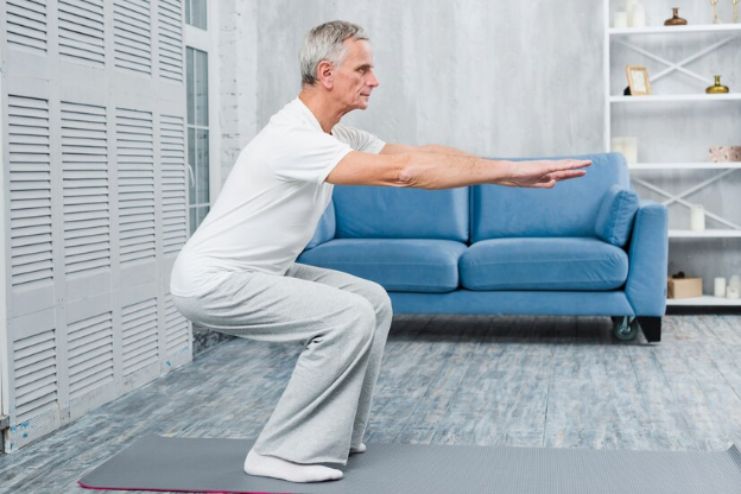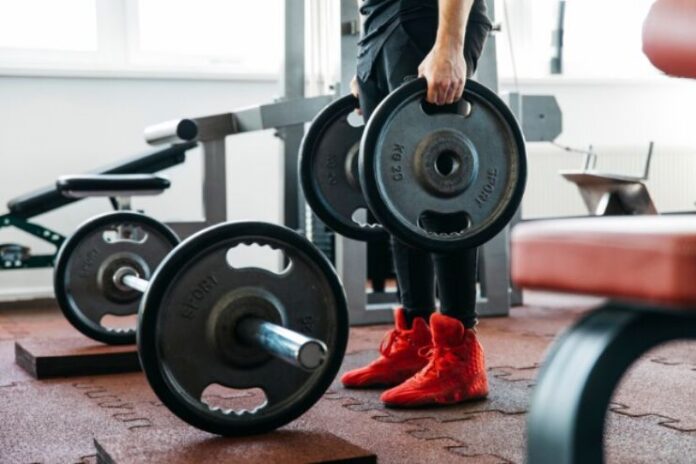Affiliate Disclaimer
Some links in this article are affiliate links. We may earn a small commission if you make a purchase through these links, at no extra cost to you. We only recommend products we find useful to our readersAs people grow older, health can be undermined by losing strength and mobility. Preserving the muscle mass of the body with strength training in addition to metabolic rate helps maintain joint health, which is a keystone of aging well.
However, as people age, muscles are lost due to a condition called sarcopenia. As a result, mobility becomes difficult, and metabolism slows, thereby increasing the chance of injuries.
The good news is that regular strength training can mitigate these problems and keep us active, independent, and strong in our old age.
In this article, we’ll cover why strength training is so important for healthy aging, how muscle loss impacts our health, and the best strength-based exercises to add to your routine.
Whether you’re just starting off with strength training or fine-tuning your workouts for longevity, we’ve got practical tips and exercises to help you build and maintain strength over the years.
Also, Read: Debunking Strength Training Myths: What Every Woman Needs to Know
How Strength Training Supports Longevity

Strength training is part of the principles of healthy aging. By doing regular resistance exercises, you not only retain muscles but also try to perfect and enhance physiological functions that support healthy aging.
- Reduces Muscle Loss (Sarcopenia) and Maintains Bone Density
With age, the muscles deteriorate; it is called sarcopenia. Strength training works against this process by triggering the growth and preservation of muscles. It also prevents bone density loss, decreasing the chances of developing osteoporosis and fractures.
- Boosts Metabolism and Prevents Weight Gain
The metabolic rate weakens with age. Strength training enhances the metabolic rate to lose or gain body weight and reduces the risk of obesity-related diseases. It also enhances one’s sensitivity toward insulin, which helps prevent type 2 diabetes.
- Enhances Balance, Coordination, and Fall Prevention
Regular strength exercises help improve balance and coordination, which is crucial to preventing falls – the most common risk for an aged person. Strengthening muscles and improving neuromuscular function enhance stability and help reduce falls.
- Supports Joint Health and Flexibility
Strength training strengthens muscles around joints by providing support, making injuries less likely. In addition, it provides flexibility, which is significant for good mobility and ideal functioning in daily activities.
Also, read: Chair Yoga for Seniors: Simple Moves to Improve Strength and Flexibility
Best Strength Training Workouts for Longevity

Here are some of the best strength training exercises for longevity:
1. Bodyweight Exercises for Functional Strength
Bodyweight exercises are excellent for developing and maintaining mobility, especially in older individuals. These exercises work for many muscle groups, enhance balance, and contribute to increased functional strength in daily life. The most important ones include:
- Squats:A nice exercise for lower body strength and balance
- Lunges: Facilitate flexibility by strengthening the legs
- Push-ups:Build the upper body, especially the chest, shoulders, and triceps
- Planks: Works the core and aims at correcting posture, stability, and balance
Also, Read: 8 Bodyweight Exercises For Strength – Do They Make You Stronger?
2. Resistance Training for Muscle & Bone Health
Maintenance of muscle mass and bone density is possible with resistance exercises. This includes dumbbells, resistance bands, and kettlebells, thus working on most major muscle groups. These include:
- Dumbbell Squats and Lunges:Increase and enhance leg strength and coordination
- Chest Presses and Rows:Work the upper body and help to keep bones strong
- Bicep Curls and Tricep Extensions: Gives strength to the arms for proper functioning
3. Core and Stability Workouts
Strengthening the core is fundamental in helping a person have good balance and posture and prevent falls. It includes exercises for the abdominals, lower back, and obliques, which are collectively in charge of stability. These exercises are:
- Bridge Lifts:Develop the muscle strength of the glutes, lower back, and core
- Russian Twists:Develop rotation and flexibility in the core
- Leg Raises: Develop the lower abdominal muscles and also support flexibility
Also, Read: Tuesday Toning: Core-Focused Pilates Session
4. Low-Impact Strength Workouts
Low-impact strength exercises such as Pilates, yoga, and Tai Chi are perfect for those with joint issues or those who wish to minimize the impact. These activities focus on slow movements, flexibility, and strength and are gentle on the joints. Some of these include:
- Pilates Leg Circles and Planks:Develop core strength and posture
- Yoga Warrior and Downward Dog poses: Enhances balance, flexibility, and joint stability
- Tai Chi Movements: Enhance coordination and balance and also tone muscles
5. Power and Explosive Movements for Active Aging Adults
These exercises help older adults sustain power and explosiveness, thus maintaining agility and strength. Light kettlebell swings, box jumps, and even plyometric exercises can stimulate fast-twitch muscle fibers, which are innately important for functional everyday strength.
These movements improve quick reflexes, balance, and strength in older adults. However, start with low-impact variations and add intensity as your fitness improves. This drastically reduces the rate of falls and injuries and is critical in advancing years.
How Often Should You Strength Train for Longevity?

To get the most out of strength training as you age, you need to balance the frequency of your workouts with recovery time and adjust your routine based on your fitness level.
Here’s a breakdown of how often you should strength train and how to structure your workouts for longevity.
1. Recommended Frequency Based on Age and Fitness Level
- General Recommendations: Strength training 2 to 3 times a week is sufficient for an average adult to retain muscle mass, bone density, and general functional strength.This frequency enables optimal muscle repair and growth and prevents your body from overworking.
- Older Adults:Those over 65 may benefit from strength training twice a week, which could include working out all major muscle groups with rest in between. The secret is to do it consistently and with progression, using lightweights or body weights and intensifying the load gradually.
2. How to Balance Strength Training with Cardio and Mobility Work
Strength training is one thing, but focus on building a more well-rounded routine. Practice cardio so that your heart is in shape, balance the body, and improve flexibility with Tai Chi, Pilates, or swimming.
- Cardio (3-5 times per week):Walking, swimming, or cycling improves heart health and overall endurance. Therefore, cardio must complement strength training for a balanced exercise program. Also read: Thursday Thrill: High-Intensity Cardio Circuit
- Stretching and Yoga (2-3 times per week): Along with strength training, stretch and do yoga. Stretching and yoga increase flexibility, reduce muscle stiffness and improve range of motion. Mobility work is a way to maintain your ability to perform daily tasks and avoid falls.
- Focus on Joint Mobility (2-3 times per week):The older you get, the more critical it is to take care of your joints. Build exercises that maintain or improve mobility, such as shoulder circles, ankle rolls, and hip openers, into your weekly routine.
3. Importance of Recovery and Rest for Muscle Repair
Rest is just as important as the workout. Muscles must have time to recover and get stronger after exercise. Here is how to properly rest:
- Active Recovery Days:On your days off from strength training, be active with low-intensity exercises such as walking or stretching.
- Sleep and Nutrition:Get in the habit of sleeping for 7-9 hours every night and feed your body the correct nutrients, with a particular focus on protein for muscle repair and recovery.
Tailoring Your Routine
It is imperative to listen to your body as you age. If you’re feeling extremely sore after a workout, the intensity or volume of training should probably be reduced.
Consult a fitness trainer, as well as a healthcare provider, to determine the best training program for your specific needs.
Additional Tips for Strength Training as You Age

To maximize working out, here are a few more tips on modifications for older adults:
1. How to Modify Workouts for Joint Health and Injury Prevention
- Use Low-Impact Movements:Bodyweight squats, step-ups, and resistance band exercises would be the perfect low-impact exercises for building strength without stressing your knees, hips, or shoulders.
- Focus on Proper Form:Poor form can lead to injuries, especially in weight-bearing exercises. Be more conscious of your posture and movement patterns. Consider initially working with a personal trainer to ensure proper form and technique, preventing unnecessary strain on joints and muscles.
- Incorporate Functional Movements:Such movements, like squats, lunges, and push-ups, mimic daily life. They build functional strength and help ensure mobility while reducing the likelihood of falls. Therefore, quality of life increases with reduced risks of injury.
2. Nutrition Tips for Supporting Muscle Recovery
- Prioritize Protein:Protein repairs muscles and also makes muscles. As you age, taking higher amounts of proteins in the body becomes critical. Include 1.2 to 1.6 grams of protein per kilogram of your body weight – prioritizing lean proteins like chicken, fish, tofu, eggs, and beans to your diet. Also read: Shake Up Your Protein Game: 7 Delicious Protein Shakes Available on Amazon
- Hydrate: Hydration is essential for proper muscle function and recovery. Drink enough water before, during, and after your workouts. Dehydration impairs muscle performance and delays recovery, so hydration should be a priority.
- Eat Anti-Inflammatory Foods: Foods rich in omega-3 fatty acids, such as salmon, walnuts, and flaxseeds, can reduce inflammation and promote muscle repair. In addition, leafy greens, berries, and other antioxidant-rich foods help combat oxidative stress that accelerates aging.
3. Stay Consistent with Your Training Routines
- Make It a Habit:Consistency is the name of the game when it comes to strength training. Choose a schedule that fits your needs, whether twice or thrice a week, and commit to it. Even on days when motivation is low, try to do a light workout or an activity that keeps your muscles active.
- Progress Gradually:Don’t try to push yourself too hard, too fast. Start with lighter weights or bodyweight exercises, and gradually increase the intensity as your strength improves. Too much intensity too fast can lead to injuries when your body isn’t ready for it. Listen to your body and adjust your routine as needed.
- Find a Support System:Having a workout buddy or joining a group class can help maintain motivation. Additionally, working out with others ensures you’re more likely to stay consistent with your routine.
Final Thoughts: Making Strength Training a Lifelong Habit
Strength training is an important component of aging well and maintaining a high quality of life. It helps preserve muscle mass, improves bone density, and enhances overall mobility and balance, all of which are critical as we age.
Start small and gradually build a routine to progress in the long term without any hindrances. Consistency, rest, and proper recovery are the keys to long-term success.
Strength training can be an excellent way for someone who is just starting or has trained for many years to keep them strong, independent, and healthy throughout life. Start embracing strength training as a habit for the rest of your life to maximize its benefits as you age healthily
References
- https://pubmed.ncbi.nlm.nih.gov/14552938/
- https://nortonhealthcare.com/news/why-strength-and-resistance-training-can-help-you-as-you-age/
- https://www.nia.nih.gov/news/how-can-strength-training-build-healthier-bodies-we-age
- https://mcpress.mayoclinic.org/healthy-aging/the-many-benefits-of-resistance-training-as-you-age/
- https://www.mayoclinic.org/healthy-lifestyle/fitness/expert-answers/strength-training/faq-20058001
- https://www.health.harvard.edu/staying-healthy/the-best-exercises-for-older-adults
- http://www.pfswellness.com/forms/ACSM_STRENGTH_TRAINING_GUIDELINES__Role_in_Body.7.pdf
- https://www.nia.nih.gov/health/exercise-physical-activity
- https://www.health.harvard.edu/blog/why-recovery-time-is-crucial-to-your-fitness-routine-202204062669
- https://www.nia.nih.gov/health/exercise-physical-activity-getting-started
- https://www.health.harvard.edu/staying-healthy/strength-training-building-strength-at-any-age
- https://www.mayoclinic.org/healthy-lifestyle/nutrition-and-healthy-eating/expert-answers/aging-and-nutrition/faq-20401688
In this Article















